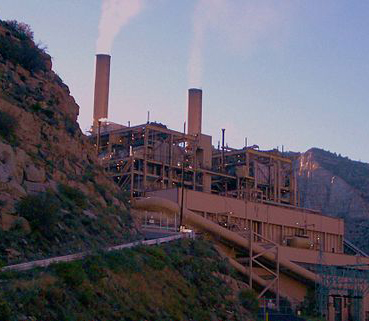
ST. GEORGE — The American Lung Association recently released its 2016 “State of the Air” report, which analyzes the two most widespread outdoor air pollutants: ozone pollution and particle pollution. While the report shows a trend of improvement in air quality nationwide, Washington County received a grade “F” for ozone pollution, a drop of two grades from the 2015 report. The county received an “A,” however, for short-term particle pollution.
The State of the Air report examines data for counties in the U.S. where measuring equipment for the U.S. Environmental Protection Agencies Air Quality System — formerly the Aerometric Information Retrieval System, or AIRS — is available.
The 2016 report contains data collected from the years 2012-2014. According to the methodology section of the report, the American Lung Association uses three years of data for the same reason as the EPA: “to prevent a situation in any single year, where anomalies of weather or other factors create air pollution levels, which inaccurately reflect the normal conditions.”
Washington County ozone levels

Often referred to as “smog,” ozone is a gas molecule which attacks lung tissue by chemically reacting to it. Ozone develops when gases from vehicle tailpipes, smokestacks and other sources come in contact with sunlight. Because ozone can be carried by wind, area ozone levels are not always reflective of ozone actually created in that area.
While ozone in the stratosphere protects people from the sun’s ultraviolet radiation, ozone at the ground level — the troposphere — can cause serious health problems. Anyone who spends a significant amount of time outdoors may be negatively affected by high levels of ozone; however, according to the American Lung Association, five groups are particularly susceptible:
- Children and teens
- People over 65 years old
- People who work or exercise outdoors
- People with existing lung diseases
- People with cardiovascular disease
“Ozone is harmful to public health and especially children, older adults and those with asthma and other lung diseases,” said Jamie Riccobono, executive director of the American Lung Association in Utah. “When older adults or children with asthma breathe ozone-polluted air, too often they end up in the doctor’s office, the hospital or the emergency room.”
To determine ozone levels for the 2016 State of the Air report, the American Lung Association started by determining the air quality level of each day in the three-year span based on the current national air quality standard for ozone: 70 parts per billion, or ppb, measured over eight hours. Depending on the levels, each day was assigned a color-coded air quality index level as follows:
- 0-54 ppb: Good (Green)
- 55-70 ppb: Moderate (Yellow)
- 71-85 ppb: Unhealthy for sensitive Groups (Orange)
- 86-105 ppb: Unhealthy (Red)
- 106-200 ppb: Very Unhealthy (Purple)
- 201+ ppb: Hazardous (Maroon)
Next, weighting factors were assigned to each category: One for orange days, 1.5 for red days, 2 for purple days and 2.5 for maroon days. Once this was determined, a weighted average was assigned to each county that determined the county’s grade.
Between 2012-2014, Washington County had 15 orange days. This resulted in an “F” grade. In the 2015 State of the Air report — which measured data from 2011-2013 — Washington County only had 3 orange days, resulting in a “C” grade.
Of the 12 other Utah counties with at least one monitor capable of collecting data, all but three also received an “F” for the 2016 report. Uintah County received the worst weighted average, with 41 orange days, 24 red days and 18 purple days.
Washington County particle pollution levels
Particle pollution is a mix of very small solid and liquid particles in the air and is created from two different processes: mechanical and chemical.

Mechanical particle pollution refers to the breaking down of bigger bits into smaller pieces, such as those created from dust storms, construction, demolition, mining operations and agriculture. Tire, brake pad and road wear also fall into this category.
Chemical particle pollution is created when gases from burnt fuels vaporize and condense to form either a particle of the same chemical compound or react with other gases or particles to form a different compound. While burning of fossil fuels is the primary contributor to particle pollution, it can also result from wood-burning stoves.
To determine the particle pollution levels, the American Lung Association used a similar weighted system. Per this system, between 2012-2014, Washington County didn’t have any days that registered above the “moderate” levels. This matched data from the 2015 State of the Air report.
Salt Lake County received the worst weighted average in the 2016 report, with 44 orange days and 11 red days. Cache County wasn’t far behind with 38 orange days and 14 red days.
See all of the 2016 Utah data for both ozone and short-term particle pollution here.
Protecting yourself from ozone and particle pollution
According to the 2016 State of the Air report, the American Lung Association has set higher standards for both ozone and short-term particle pollution than the EPA. A county that receives an “F” may still meet the EPA’s 2015 ozone standard. The report states:
The American Lung Association’s position is that the evidence shows that the 2015 ozone standard, although stronger than the 2008 standard, still fails to adequately protect public health.
The American Lung Association offers the following suggestions to protect yourself from ozone and particle pollution:
- Pay attention to forecasts for high air pollution days to know when to take precautions
- Avoid exercising near high-traffic areas
- Avoid exercising outdoors when pollution levels are high, or substitute an activity that requires less exertion
- Do not let anyone smoke indoors and support measures to make all places smoke-free
- Reduce the use of fireplaces and wood-burning stoves
Resources
Email: [email protected]
Twitter: @STGnews
Copyright St. George News, SaintGeorgeUtah.com LLC, 2016, all rights reserved.
Are you sure that “Haze photo” is not from the Pine Valley Mountain fire on September 8th 2016? When exactly was that “stock” image taken?
Common Sense, thank you for inquiring on this photo. That particular photo came from the following linked story published on Aug. 19, 2015.
http://www.stgeorgeutah.com/news/archive/2015/08/19/jla-haze-southern-utah-air-quality/#.Vyd3nvkrK00
Thanks for reading St. George News
Paul Dail
Editor, Reporter
I wish the county would reduce the number of permitted fires.
I wonder how many of these burns that are being done even have a permit to burn
I bet some folks out there are going to blame this on Volkswagen. I would start pointing fingers at all of the big trucks with giant stupid looking exhaust blowing black smoke all over people sitting at a red light. Duramax, Cumming, and Power stroke are the perps! Or maybe its the farm diesel these hicks are using out here. From what I understand, if the Feds found out farm fuel is being used, somebody is going to get a heck of a fine.
It’s Bush’s fault
I agree about some of the trucks I see –
when they step on the gas, huge clouds of black smoke come billowing out – worse than the 18 wheelers!
Shouldn’t they have some kind of filter for that? HORRIBLE if you have your car windows open – ICK!
And this is why Washington County should implement smog tests for every vehicle or one day St. George will soon look like the Wasatch Front.
Dot, you are going to have to move out of Washington county your carbon dioxide is affecting the ozone
Ladynut you need to leave the solar system your BS is affecting the lunar orbit and the Martians don’t want you infecting their environment.
Oh btw ladynut. go back on vacation you made more sense when you were gone